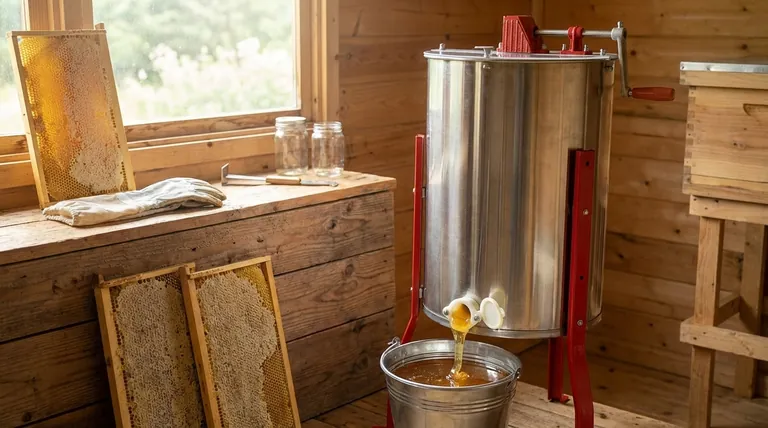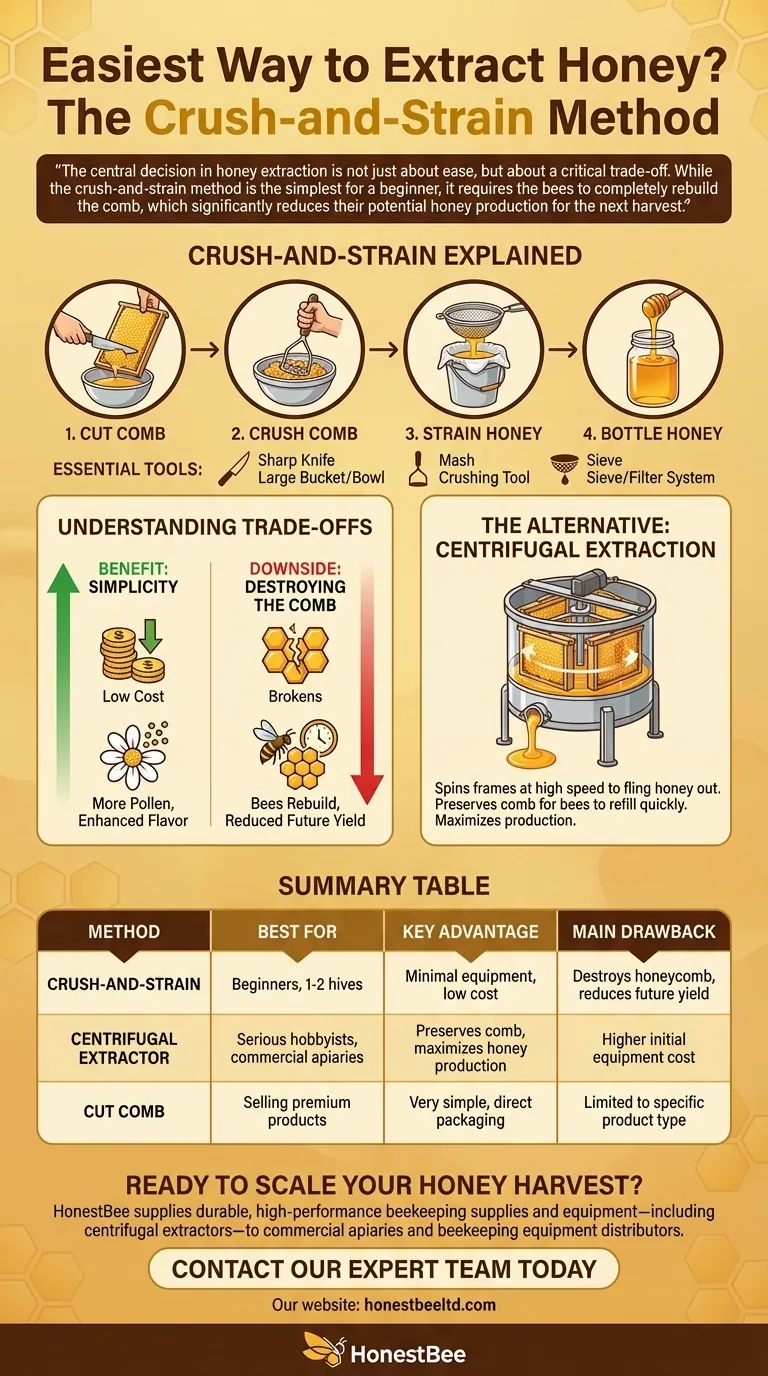By far, the easiest way to extract honey is the crush-and-strain method. This is the oldest and most straightforward technique, requiring minimal specialized equipment. You simply cut the honeycomb from its frame, crush it entirely to break open the wax cells, and then strain the mixture to separate the liquid honey from the solid wax.
The central decision in honey extraction is not just about ease, but about a critical trade-off. While the crush-and-strain method is the simplest for a beginner, it requires the bees to completely rebuild the comb, which significantly reduces their potential honey production for the next harvest.

The Easiest Method: Crush-and-Strain Explained
This method is perfect for first-time beekeepers or those with only one or two hives, as it avoids the cost and complexity of mechanical extractors.
What is Crush-and-Strain?
The principle is simple destruction and separation. By crushing the comb, you physically break open every wax-sealed cell, releasing the honey. Gravity then does the work, allowing the honey to drain through a filter, leaving the beeswax behind.
Essential Tools for This Method
You can perform this method with basic kitchen equipment, but a few dedicated tools make it cleaner.
- A Sharp Knife: To cut the comb out of the frame.
- A Large Food-Grade Bucket or Bowl: To hold and crush the comb.
- A Crushing Tool: A simple potato masher or even your clean hands will work perfectly.
- A Sieve or Filter System: This can be a double sieve (coarse and fine) or layers of cheesecloth placed over another clean bucket.
A Simple Step-by-Step Guide
- Clear the Bees: Gently brush any remaining bees off the honeycomb frames using a soft bee brush.
- Cut the Comb: Place a frame over your bucket and use a knife to carefully cut the entire honeycomb away from the wooden frame.
- Crush the Comb: Let the comb fall into the bucket. Use your masher or hands to crush it thoroughly until it is a single, unified slurry of honey and wax.
- Strain the Honey: Pour the mixture into your sieve or filter system, which should be resting on a clean bottling bucket. Cover it and let it drain. This can take several hours.
- Bottle Your Honey: Once drained, the honey in the bottom bucket is ready to be transferred into jars.
Understanding the Trade-offs
Choosing an extraction method is about balancing simplicity against efficiency and long-term hive health. The easiest way is not always the most productive.
The Benefit of Simplicity
The primary advantage of the crush-and-strain method is its low barrier to entry. There is no need to buy an expensive centrifugal extractor. Additionally, this method often leaves more pollen in the final product, which can enhance its flavor and nutritional profile.
The Downside: Destroying the Comb
The most significant drawback is the destruction of the beeswax comb. Bees expend a tremendous amount of energy and consume large amounts of nectar to produce wax and draw it into a perfect hexagonal comb.
When you destroy the comb, you force the colony to start from scratch. This effort diverts resources that would otherwise be used to gather nectar and produce more honey, directly impacting the size of your next harvest.
The Alternative: Centrifugal Extraction
A centrifugal extractor is a machine that spins the frames at high speed. This force flings the honey out of the cells without destroying the comb.
After extraction, the empty "wet" frames are returned to the hive. The bees quickly clean them and can begin refilling them with honey almost immediately. This is why commercial operations and serious hobbyists always use extractors—it maximizes honey production.
Making the Right Choice for Your Goal
Your beekeeping goals should dictate your extraction method.
- If your primary focus is learning with one or two hives: The crush-and-strain method is the perfect starting point. It allows you to harvest honey with minimal financial investment.
- If your primary focus is maximizing honey yield for multiple hives: Investing in a centrifugal extractor is the most effective long-term strategy. It respects the bees' hard work and leads to larger, more frequent harvests.
- If your primary focus is selling premium, natural honey products: Consider the "cut comb" method. Here, you simply cut clean squares of capped honeycomb and package them directly, which is arguably even simpler than crush-and-strain.
Ultimately, choosing your method is about aligning your equipment and effort with the scale of your ambition.
Summary Table:
| Method | Best For | Key Advantage | Main Drawback |
|---|---|---|---|
| Crush-and-Strain | Beginners, 1-2 hives | Minimal equipment, low cost | Destroys honeycomb, reduces future yield |
| Centrifugal Extractor | Serious hobbyists, commercial apiaries | Preserves comb, maximizes honey production | Higher initial equipment cost |
| Cut Comb | Selling premium products | Very simple, direct packaging | Limited to specific product type |
Ready to Scale Your Honey Harvest?
The crush-and-strain method is perfect for starting out, but to maximize the productivity of your apiary, you need the right equipment. HONESTBEE supplies durable, high-performance beekeeping supplies and equipment—including centrifugal extractors—to commercial apiaries and beekeeping equipment distributors through our wholesale-focused operations.
Let us help you increase your honey yield and operational efficiency. Contact our expert team today to discuss your needs and get a quote on the right equipment for your business.
Visual Guide

Related Products
- 2 Frame Stainless Steel Manual Honey Spinner Extractor for Beekeeping
- 6 Frame Manual Stainless Steel Honey Extractor Beekeeping Equipment
- HONESTBEE 3-Frame Manual Acrylic Honey Extractor
- Electric 8 Frame Honey Spinner Extractor Equipment for Beekeeping
- Stainless Steel 3 Frame Manual Honey Extractor Spinner for Bee Honey Extraction
People Also Ask
- What are some tips for using a honey extractor effectively? Maximize Your Honey Yield and Protect Your Comb
- How do beekeepers harvest honey from the honey super? A Step-by-Step Guide to Efficient Extraction
- How can a pressure washer be used to clean a honey extractor? A Guide to Safe and Efficient Cleaning
- What are some expert tips for cleaning a honey extractor? Protect Your Harvest & Equipment
- Can a manual extractor be upgraded to an electric one? Save Labor & Boost Efficiency



















